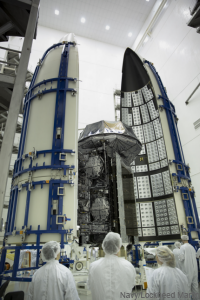Navy launches third satellite for global communications system
MUOS will eventually be a five-satellite constellation forming a smartphone-like network for secure, high-bandwidth communications.

The Navy this week successfully launched the third satellite in its Mobile User Objective System, which is intended to provide secure, high-bandwidth global communications for forces on the ground.
The Mobile User Objective System-3 satellite, or MUOS-3, has been outfitted to support the current user base of roughly 200,000 ground terminals and carries a payload to support future terminals, the Navy said. The dual payloads will assist in a smooth transition from the old system to the new. Additional equipment and capabilities include “Wideband Code Division Multiple Access (WCDMA) payload that provides a 16-fold increase in transmission throughput over the current Ultra High Frequency (UHF) satellite system,” according to contractor Lockheed Martin.
The Navy compares MUOS to a smartphone network that will provide “global, on-demand, beyond-line-of-sight capability to transmit and receive high-quality voice and mission data from a high-speed Internet Protocol-based system,” unlike its predecessor.
The MUOS constellation program is designed to provide secure communications between soldiers globally while connecting classified and unclassified networks with Defense Department phone systems. It will immediately benefit dismounted, ground-based mobile users that use secure voice data during operations. However, ships, aircraft, and other vehicles also can benefit from MUOS’s capabilities.
The first two installments of the eventual five-piece orbital constellation were launched in 2012 and 2013. Aside from the extraterrestrial component, MUOS consists of four ground stations that use intricate software programs to manage the entire system. Those first parts of the system were tested in the Arctic in May 2013 as part of the Navy’s Ice Exercise.
MUOS also could support small cube or nano satellites that could extend the range of communications or support specific mission.
As for the MUOS-3, it is a 7.5-ton spacecraft that was launched atop an Atlas V rocket by United Launch Alliance, a combined effort by Lockheed Martin and Boeing.



